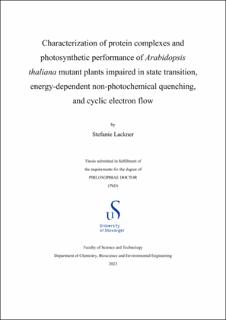| dc.description.abstract | For optimal photosynthesis, the photosystem complexes in the plant leaf adapt to their light environment. In a process termed “state transition”, light energy distributes between photosystem II (PSII) and photosystem I (PSI), which is regulated by exchanging a mobile light-harvesting antenna complex termed LHCII. When light intensity rises, mobile LHCII is phosphorylated by the protein kinase state transition 7 (STN7), and the area of single membrane layered parts of the thylakoid membrane - termed stroma thylakoid membrane increases. The kinase STN7 was shown to localize in a complex with the cytochrome b6f (Cytb6f) complex. The regulation of the kinase activity correlated with the reduction state of the plastoquinone pool1. Also, a corresponding LHCII phosphatase termed phosphatase 1 (PPH1 or TAP38) has been identified as constitutively active. According to the established models for regulation of light energy distribution, two states have been defined: In state 1, nonphosphorylated LHCII is binding to PSII, and the number of grana layers is increased, whereas in state 2, phosphorylated LHCII is binding to PSI and the number of grana layers is decreased. Recently, it was found that the binding of phosphorylated LHCII to PSI and membrane biogenesis during state transition operate independently. Also, the shift between cyclic (CEF) and linear (LEF) photosynthetic e- flow was claimed to be independent of state transition but controlled by the dynamic thylakoid membrane changes2. According to one of the latest models, an increase in grana layers increases CEF based on a separation of the grana localized plastoquinone (PQ) pool(s) from the stroma thylakoid membrane, while more stromal thylakoid layers and decreased grana stacks facilitate an increase in LEF3. Another proposal assumes that at low-intensity light, in the stn7 mutant- with increased grana stacks decreases the capacity to perform CEF and LEF, while in the pph1 mutant- with a reduction in grana layers and increase in stroma thylakoid surface is increasing LEF and CEF2. In an attempt to differentiate between changes associated with the phosphorylation of LHCII and with the flow of electrons, mutants lacking STN7 (the stn7 mutant), PPH1 (the pph1 mutant), and mutants lacking a functional NADH dehydrogenase-like (NDH) complex (the crr-22 mutant referred later to as crr2) or proton gradient regulation 5 (PGR5) (the pgr5 mutant) were investigated. In addition, the role of qE- the fastest form of nonphotochemical quenching (NPQ) was examined using the npq4 mutant, which lacks qE because the Photosystem II chlorophyll-binding protein (PsbS) is knocked out. Mutants were grown under standard light regimes. The composition of protein complexes in the stroma thylakoid membrane was examined, and the plant’s capacity to adapt to low and close to growth light intensity and increasing light intensities was measured. We found that the mutants stn7 and pph1, as well as the npq4, crr2, and pgr5 mutants change the thylakoid distribution of photosystem complexes as well as the composition of electron flow.
In this study, we found an increase in higher molecular weight (HMW) complexes and phosphorylated LHCII molecules in the stroma thylakoid membrane in both the pph1 and the crr2 mutant. In contrast, fewer HMW complexes were found in the stn7 mutant characterized by an increase in grana stacking, and more PSI-Cytb6f complexes were present. When looking at the photosynthetic performance at actinic light close to growth light conditions, LEF was both enhanced in the pph1 and the crr2 mutant, while in the stn7 and the npq4 mutant, CEF was favored. We propose that both the pph1 and the crr2 mutant have a more balanced light utilization at PSII and PSI which is favoring LEF, while in the stn7 and the npq4 mutant, more light is utilized at PSI relative to PSII facilitating CEF. Therefore, our observations indicated that like in the state transition mutants, also the npq4 mutation plays a role in the distribution of light between PSII and PSI. When NDH-dependent CEF is absent in the crr2 mutant, an increase in PGR5-dependent CEF was noticed, while in the pgr5 mutant, after the onset of actinic light when low or close to growth light conditions were used, the mutant was depending on LEF only. The amount of phosphorylated LHCII was increased in the pgr5 mutant, and a far-red (FR) light-induced state 2- to- state 1 transition was slower relative to WT indicating that the absence of PGR5/PGRL1-dependent CEF was facilitating LEF. After prolonged illumination with low (below growth light) actinic light, the plant switches from state 2- to- state 1 and increases NDH-dependent CEF relative to LEF. In both pgr5 and stn7 mutants, NDH-dependent CEF was enhanced. An increase in NDH-dependent CEF was absent in the crr2 mutant and reduced or missing in the pph1 mutant. In the crr2 mutant, we have observed an increase in phosphorylated LHCII at PSI. This observation lets us hypothesize that the arrested binding of phosphorylated LHCII to PSI in the pph1 mutant, interferes with the binding of the NDH complex. We hypothesize that a functional NDH-dependent CEF is established by NDH complex assembly with PSI in state 1- when the PQ pool is in an oxidized state. In contrast, under conditions such as after dark preincubation and under HL when the PQ pool is in a reduced state PGR5/PGRL1-dependent CEF is employed. On the opposite, when prolonged illuminated under growth light conditions the plant favors LEF over the performance of PGR5/PGRL1-dependent CEF. | en_US |
